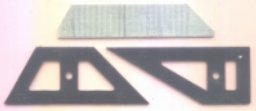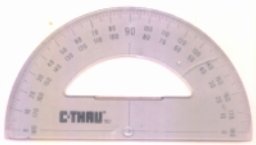Alignment of angles crops up everywhere. A very wide variety of devices and sizes have been developed to handle almost any situation, including optical and the newer laser types. Some may have measuring graduations, movable blades and accessories such as scribers bevels and center finders. But only a select few are applicable to hobbies. Sometimes selecting the right one "is a puzzlement".
Since the most common are right or perpendicular angles, squares are the most common devices. Ranging from small machinist to large framing or rafter types.
Among the most useful for model making is the machinist square with blades starting at 2" and up. These are precision ground on all surfaces, any of which can be used. The inside handle corner is relieved and the outside blade corner is notched for clearance. Although they are designed for alignment of machine tools and work, they fit nicely inside rolling stock and structures for squaring corners. Do not overlook the use of bar stock, of shape similar to the handle, for tighter fits.

Note: Adjust brightness and contrast for optimum viewing.
2" MACHINISTS SQUARE.
Small movable combination "squares" are useful for less critical applications, where others will not fit. This one has graduated blade, square, 45 degree, center finder, scriber, and bubble level. Larger, more expensive versions may have a protractor.

Note: Adjust brightness and contrast for optimum viewing.
4" BLADE COMBINATION SQUARE.
Larger sizes are available in both fixed and combination, which may be useful on benchwork, including inexpensive try squares. But for long distances and marking layouts on plywood for cutting, framing or rafter squares may be required. These are usually available in 24 x 36" or 36 x 48" in steel or lighter aluminium. They are frequently marked for rafter slopes, which do not help much for setting accurate grades.

Note: Adjust brightness and contrast for optimum viewing.
SMALL FRAMING SQUARE.
8" X 12"
Used for drywall, a tee-square type that spans a 4' sheet of plywood, has a movable cross-piece that can be turned to marked or any angle for laying out parallel yard tracks, or straight for storage.

Note: Adjust brightness and contrast for optimum viewing.
SHEETROCK or DRYWALL SQUARE.
To avoid using cumbersome framing squares, newer, smaller aluminum or plastic triangular substitutes have been developed with added features. This one claims to replace a try square, miter, protractor, line guide and saw guide. Instructions include a table for rafter settings. A lip on either side can help align vises and pieces on milling and drilling tables for none critical work. At less than $3, one could be cut down for smaller use.

Note: Adjust brightness and contrast for optimum viewing.
5 IN 1 SQUARE
8" X 8"
Too often standard squares do not fit, requiring a search for ersatz substitutes. Dice are multi-faced squares with reasonable precision for aligning car and structure walls plus three plane corners. A boon is to have relatives, who are dealers in nearby casinos for an inexhaustible supply of fairly PRECISE dice. The practice is to drill holes clean through discarded dice to prevent reuse and alteration by sharks. The holes are useful in manipulation, clamping and even mounting handles. Edges and corners can be rounded or beveled to avoid cement contact.

Note: Adjust brightness and contrast for optimum viewing.
DICE
Discarded casino
Game
Fixed common angles are usually setup with various triangles. Some may be flat like drafting triangles, while others may have guides, similar to square handles, to align with established references such as table edges or slots.

Note: Adjust brightness and contrast for optimum viewing.
NWSL ANGLES
Old metal
New plastic
Odd angles require bevel or miter gauges. Although the same devices may be used for either, bevels are parallel to the major axis of the work, while miters are across it, with the difference sometimes ill defined. Some cuts may require compound angles, as in the faces of a tetrahedron.
Often used by carpenters and woodworkers to duplicate angles, the simplest tool is a miter gauge. Very similar to a square in construction and use, it features an adjustable blade that is set and locked before use.

Note: Adjust brightness and contrast for optimum viewing.
SIMPLE MITER GAUGE,
7" blade
The most common calibrated device is the protractor used in drawing. Although it is helpful in measuring angles with reasonable accuracy, it does not perform well in establishing layouts for work; since it requires the use of a carefully placed and held straight edge.

Note: Adjust brightness and contrast for optimum viewing.
PROTRACTOR
Overcoming the difficulties and often referred to as a bevel gauge, machinists use a similar tool with legs for less critical setups. This one has center finder, drill point gauge, and 5, 6, 7, 8, 9 circle divider.

Note: Adjust brightness and contrast for optimum viewing.
MACHINISTS PROTRACTOR.
A very handy tool to set up and measure odd angles is a protractor with arms and 10 minute vernier. By juggling the positions almost any type angle can be handled.

Note: Adjust brightness and contrast for optimum viewing.
ARM PROTRACTOR.
Many power and hand tool, square or miter accessories can be used elsewhere. Sometimes they are just the right thing.
For very accurate angles, machinists use INDICES AND DIVIDERS . Both are designed to mount on milling tables and support fixtures to hold work, but they can be used elsewhere. Through the use of stops, dividers can set fixed angles from 1/60 of a circle (6 degrees) to 180 degrees or divide circles into up usually 30, 36, 40, 48 or 60 parts. For odd angles an index can be set by a dial calibrated in 1/10 degrees or sometimes 10 minutes (1/6 degree). These values are accurate enough for frog angles.
Grade percentages or angles are best measured with a MODIFIED, SENSITIVE BUBBLE LEVEL of sufficient length to span the run. Short dial type levels are almost useless, since they can not be set accurately enough and are too short, so that even a minor irregularity can through off the reading. A steep 3% grade is only about 1.7 degrees, while the difference between 1.5% and 1.0% is less than 0.3 degrees. For accurate GRADES, even with a 50" leveling distance, measurements will be in the order of .01". Better quality levels specify bubble accuracy.
BACK TO ALIGNMENT AIDS
BACK TO MEASURING
BACK TO TOOLS INDEX
